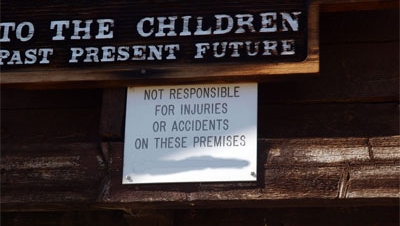The importance of speed Humps
A medical resident in Oakland, Calif., recently did an unusual study and it was published in a major health care journal. She did a tally of records from the emergency room that sees most of the seriously injured children in that area. She found that a child who lived within a block of a speed hump had half the chance of being hit and injured by a car compared to one without that bump close by. Speed humps slow cars and apparently save lives.
So should you be running to your local government to demand speed bumps on those hazard spots adjacent to your playground, those street areas that cause you to suck in your breath when oblivious children run toward them and equally oblivious adults in cars whiz by too fast?
Actually, you will be more likely to get something done and have that something be really helpful if you know a little about both the traffic engineering and political worlds you are stepping into.
Speed bumps are just one of the most widely used measures in a whole segment of traffic engineering called “traffic calming.” Used in Europe for some time, traffic calming has spread quickly in many U.S. areas over the last ten or 15 years.
It involves a number of usually physical, usually self-enforcing reconfigurations of streets to slow drivers down, cut down on traffic volume or otherwise make streets safer. It includes raised cross-walks and raised intersections, which slow cars, make pedestrians more visible and make the area more like “pedestrian territory.”
Sometimes stretches of pavement are textured to give cars a slightly rougher ride and thus slow drivers down. There are also street closures and street entrances that close streets in one direction.
Curb extensions that narrow the street for a short distance also slow cars. “Chicanes” are curb extensions that curve out for a few yards, first on one side and then the other, causing cars to slow in order to drive in an S-shaped pattern around them. Then there are center islands that give pedestrians a refuge and slow traffic. Traffic calming also includes traffic circles and roundabouts, as well as islands that force cars to turn off the street.
In an example of something that might help at a playground, Robert Seyfried, director of transportation engineering at Northwestern University’s Center for Public Safety, says a sidewalk that bulges a little into the street at a crossing point can slow cars and make children, as they start to cross, higher and more visible to drivers.
Speed bumps are used a lot because they are the least expensive traffic calming device, according to Reid Ewing, PhD, a professor at the University of Maryland who literally wrote the book on traffic calming.
Speed humps are wider and gentler than the speed humps sometimes still used in parking lots. Most traffic engineers now consider bumps too jarring for a street.
There are other configurations as well and communities have also used some creative combinations. Traffic engineers have little doubt that, done correctly, these measures tame some scary traffic.
But to get an idea what, if anything, might be good for your hot spot you want to start with your local traffic engineer or traffic engineering department. Seyfried says that towns with a population over 50,000 are likely to have a traffic engineer. That person or department is often within the transportation, public works or planning department. In other communities the city engineer may do some traffic engineering. Or officials or police departments may do or contract for the work, or hire a traffic engineering consultant to help.
When you find whoever is in charge, you want to ask if your area does traffic calming, what kind it usually does and if it has an area-wide plan. You may want to have some notes in hand and be ready to describe your particular concerns.
After you get traffic engineers involved, they may do a study of your streets, to get actual numbers on volume and speed of traffic. They might decide to install a temporary device before building a permanent one, to see how it works.
At some early point you should get local residents and playground users up to speed on your request. It’s almost a mantra among traffic engineers that to prevent a revolt you want people to understand, and hopefully to desire, the traffic calming adjustments.
Traffic engineers in Oakland, where the emergency room study was done, have installed so many speed bumps they believe their city is speed bump capital, U.S.A. But they say a huge part of their success is in preventing backlash: two-thirds of the residents on a block must sign a petition for a speed bump before one is placed.
In the meantime, you should know about some traffic calming issues that can come up. Traffic engineers consider traffic calming much more feasible on side streets than on major arteries. Ewing says a few jurisdictions are now using the devices slightly more often on heavily traveled streets. But you are still much more likely to get a device installed if you are not talking about clogging up a major street.
Some communities are still skittish about legal liability. What if a car drives over one of these devices at full speed and goes flying? Will the city be paying megabucks after a lawsuit is brought against it?
That hang-up seems to be more about officials’ fear than reality. Ewing’s recent survey of 20 communities that do traffic calming found only three such lawsuits in recent 2005s: two were decided in the cities’ favor and one was settled out of court.
In general, Ewing thinks, a program that is well designed and administered can avoid liability. And as traffic calming becomes more widely accepted, the public, the elected officials and the courts are less likely to see it as some crack-brain idea that could or did get somebody hurt.
A more realistic fear is the fact that traffic calming can increase response times for emergency vehicles. That’s a problem that is never completely solvable, Seyfried explains.
“The purpose of traffic calming is to slow down the vehicle,” he says. So fire trucks, police cars and ambulances will have some seconds added to their time with every device along their way. It’s a trade-off communities have to make decisions about.
Some communities are alleviating the problem by involving the fire department and other emergency responders in traffic calming planning. They study emergency routes and attempt not to place many devices on any one route. That becomes another reason for not putting many of the devices on major streets.
They also do the studies to ensure that a long fire truck can get around a center island or other device. You should also be aware of a positive argument for traffic calming, beyond safety: With the numbers showing that we are killing ourselves with obesity, one way officials hope to get people moving is by making streets more pedestrian-friendly, which means quieter and safer. That can tie into traffic calming.
Then there is the forever-present issue of money. Some communities have a budget for traffic calming and some pay for it from a general fund. Either way you are up against other priorities.
Some localities allow residents to pay for their own traffic calming measures, directly or through special levies, after a spot is approved for one of the devices. Speed bumps, usually the least expensive intervention, usually cost under $2,000, says Ewing. However, some communities fear that letting citizens pay will lead to wealthier neighborhoods getting safer streets, while poorer areas do not.
After you know how things work, most traffic engineers would plead that if there is a traffic calming plan in place, you try to work within it. You don’t want to cause drivers to avoid one street only to crowd on to another one, making it more hazardous.
You also need traffic engineering advice, says Ewing, to avoid poor solutions, which could lead to liability or just to officials not considering another configuration for a long time.
Seyfried points out that there are also measures to consider that are not defined as traffic calming. A fence can provide more control over the directions children run. Prohibiting parking on one side of the street may prevent children from dashing out between parked cars. If you do push for traffic calming, remember there are no pat answers. Despite the increase in use of traffic calming, it is still as much an art as a science. Traffic engineers feel sure it makes streets safer, but Ewing says there’s been very little study in this country on how much safer or what works best where.
On the other hand, if done well, traffic calming may allow you the relief of seeing fewer cars on the street or of observing drivers slow down just enough so they could stop before hitting that child.












Add new comment